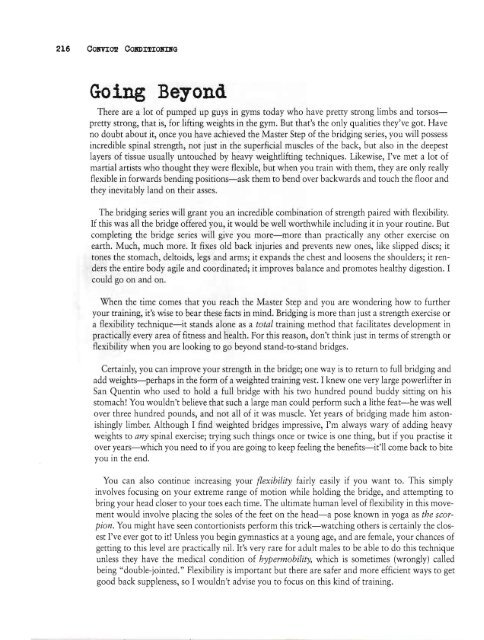Convict Conditioning - Paul Wade
You also want an ePaper? Increase the reach of your titles
YUMPU automatically turns print PDFs into web optimized ePapers that Google loves.
216 OOBVI~ OOBDI!I!IOlllllG<br />
Going Beyond<br />
There are a lot of pumped up guys in gyms today who have pretty strong limbs and torsospretty<br />
strong, that is, for lifting weights in the gym. But that's the only qualities they've got. Have<br />
no doubt about it, once you have achieved the Master Step of the bridging series, you will possess<br />
incredible spinal strength, not just in the superficial muscles of the back, but also in the deepest<br />
layers of tissue usually untouched by heavy weightlifting techniques. Likewise, I've met a lot of<br />
martial artists who thought they were flexible, but when you train with them, they are only really<br />
flexible in forwards bending positions-ask them to bend over backwards and touch the floor and<br />
they inevitably land on their asses.<br />
The bridging series will grant you an incredible combination of strength paired with flexibility.<br />
If this was all the bridge offered you, it would be well worthwhile including it in your routine. But<br />
completing the bridge series will give you more-more than practically any other exercise on<br />
earth. Much, much more. It fixes old back injuries and prevents new ones, like slipped discs; it<br />
tones the stomach, deltoids, legs and arms; it expands the chest and loosens the shoulders; it renders<br />
the entire body agile and coordinated; it improves balance and promotes healthy digestion. I<br />
could go on and on.<br />
When the time comes that you reach the Master Step and you are wondering how to further<br />
your training, it's wise to bear these facts in mind. Bridging is more than just a strength exercise or<br />
a flexibility technique-it stands alone as a total training method that facilitates development in<br />
practically every area of fitness and health. For this reason, don't think just in terms of strength or<br />
flexibility when you are looking to go beyond stand-to-stand bridges.<br />
Certainly, you can improve your strength in the bridge; one way is to return to full bridging and<br />
add weights-perhaps in the form of a weighted training vest. I knew one very large powerlifter in<br />
San Quentin who used to hold a full bridge with his two hundred pound buddy sitting on his<br />
stomach! You wouldn't believe that such a large man could perform such a lithe feat-he was well<br />
over three hundred pounds, and not all of it was muscle. Yet years of bridging made him astonishingly<br />
limber. Although I find weighted bridges impressive, I'm always wary of adding heavy<br />
weights to any spinal exercise; trying such things once or twice is one thing, but if you practise it<br />
over years-which you need to if you are going to keep feeling the benefits-it'll come back to bite<br />
you in the end.<br />
You can also continue increasing your flexibility fairly easily if you want to. This simply<br />
involves focusing on your extreme range of motion while holding the bridge, and attempting to<br />
bring your head closer to your toes each time. The ultimate human level of flexibility in this movement<br />
would involve placing the soles of the feet on the head-a pose known in yoga as the scorpion.<br />
You might have seen contortionists perform this trick-watching others is certainly the closest<br />
I've ever got to it! Unless you begin gymnastics at a young age, and are female, your chances of<br />
getting to this level are practically nil. It's very rare for adult males to be able to do this technique<br />
unless they have the medical condition of hypermobility, which is sometimes (wrongly) called<br />
being "double-jointed." Flexibility is important but there are safer and more efficient ways to get<br />
good back suppleness, so I wouldn't advise you to focus on this kind of training.


